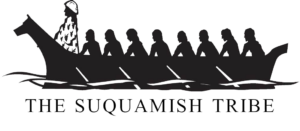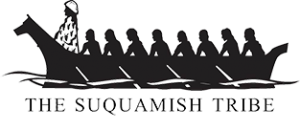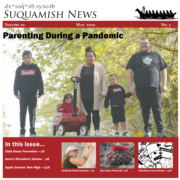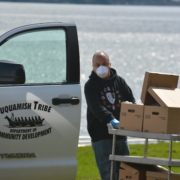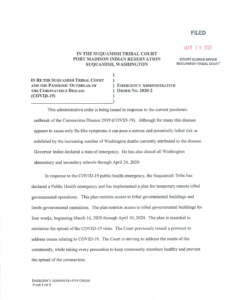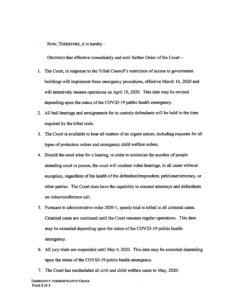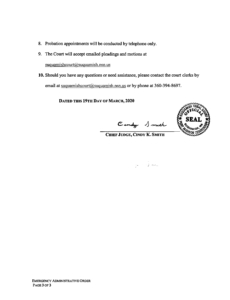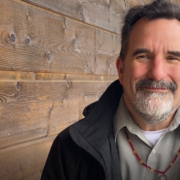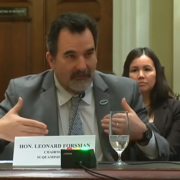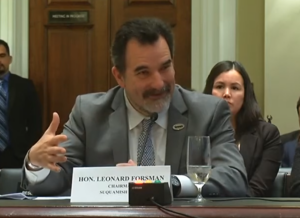Suquamish Tribe COVID-19 Vaccine Survey
FOR SUQUAMISH TRIBAL MEMBERS AND THEIR FAMILIES ONLY
The Suquamish Tribal Council has opted to provide the Moderna COVID-19 vaccine to Tribal members who would like to receive it.
The purpose of this survey is to gauge how many people will be interested in getting the vaccine so that staff can be better prepared to distribute it.
There are only five brief questions and all responses are completely anonymous.
If you are certain others in your household won’t take the survey but you are reasonably sure of their answers, feel free to take the survey again for each person. Just click on the link you received and reanswer all the questions.
The Moderna vaccine requires two shots in order to receive full protection. The second shot must be given a month after the first. Both shots will be administered by Tribal staff on Port Madison Indian Reservation.
When both doses are taken, the Moderna vaccine provides 95 percent protection against COVID-19. Most side effects are a good sign that the vaccine is working as intended.
Now Accepting Applications for Suquamish Tribe Boards and Commissions
The Tribal Council is seeking applications from Tribal members for appointment to Executive Board positions that are up on December 31, 2020. To apply for appointment, please complete the following form.
You may also submit letters of interest to Rebecca Purser, Tribal Council Executive Assistant, by mail at PO Box 498, Suquamish WA 98392, or by email to BoardsCommissions@Suquamish.nsn.us. This form and any supporting material must be submitted by the end of business on December 4, 2020.
Current board and commission members whose terms are expiring should also complete this process if you would like to renew your term.
Suquamish Updates Now Sign-up
Welcome to Suquamish Updates Now (SUN) sign-up! (Note: If you’ve already been getting SUN alerts and want to update your information, please click here.)
SUN is a free service that enables you to receive the most important, critical information that you need from the Suquamish Tribal government.
Suquamish Updates Now (v3)
Tribe Delivers to Elders in Need
Dozens of Suquamish Tribe staff members came together at the House of Awakened Culture on Thursday and Friday morning to prepare boxes of groceries for home delivery to eligible Tribal Elders in need residing in the local area. The groceries were primarily for Elders who did not have family members in the immediate area who could shop for them.
The deliveries will supply the Elders with enough food to last two weeks.
Made possible by the blessing of Tribal Council, the food packaging and delivery was accomplished through the joint efforts of Human Services, Community Development, Emergency Management, Maintenance, Clearwater Casino Resort, and Suquamish Tribe Administration.
Suquamish Tribal Court available for limited operations
The Suquamish Tribal Court will be available for limited operations, until further notice.
All bail hearings and arraignments for in custody defendants will still be held in the time required by Tribal Code. The court is also still available to hear all matters of an urgent nature, including requests for protection orders and emergency child welfare orders. In order to minimize the spread of Covid-19, the court will use video/conference calls for all hearings.
For more details, see the Emergency Administrative Order below.
If you have any questions, contact the court clerk at (360) 394-8697 or suquamishcourt@suquamish.nsn.us
Chairman Forsman provides update on Covid-19 Response
Chairman Leonard Forsman provides this March 17 video update to the Suquamish Tribal community on the Tribe’s responses to the Covid-19 outbreak.
Questions, comments, or concerns can be sent to: covid_questions@suquamish.nsn.us
Suquamish Tribe Chairman Calls on U.S. Congress to Adopt Native Voting Rights Modeled on Washington State
Washington State’s Native American Voting Rights Act is a model the rest of the United States should follow as the 2020 election season begins. This is the message brought to Washington, DC by Leonard Forsman, Chairman of the Suquamish Tribe and President of the Affiliated Tribe of Northwest Indians.
Forsman testified today before the Elections Subcommittee of the Committee on House Administration at a hearing entitled “Native American Voting Rights: Exploring Barriers and Solutions.” The hearing took place at the Longworth House Office Building.
Forsman described the many barriers to voting facing Native people across the United States.
Among them, jurisdictions that refuse to accept Tribal IDs for those registering to vote. Some tribal citizens also lack the type of home addresses that correlate with the standard address system. Instead, many use PO Boxes or other addresses not accepted for establishing residency.
A third barrier is the locations of ballot drop boxes that are often outside of reservation boundaries and available only for limited hours. “This created a hardship for many tribal citizens that do not have means of transportation,” said Forsman.
Washington State’s Native American Voting Rights Act, or NAVRA, adopted by the state legislature on March 5, 2019, helped fix each of these challenges. Forsman urged the committee to consider similar provisions as Congress addresses voting rights issues nationwide.
Specifically, Washington’s NAVRA allows:
- Tribal citizens in Washington State to use tribal IDs to register to vote.
- Tribes to request that at least one ballot box be located on their reservation. The tribe can choose the location.
- Tribal citizens to use nontraditional residential addresses for voter registration. The location of the tribally designated ballot box can serve as their address, which is especially important for homeless citizens and others without a stable residence.
“Since the passage of NAVRA, tribes in Washington are now partners with the State,” Forsman said. “The Suquamish Tribe is now able to have direct involvement with the state in planning and ensuring that our people do not face obstacles while exercising their right to vote.”
Forsman, who is also a member of the Executive Board for the National Congress of American Indians, noted NCAI strongly favors legislation such as HR 1694, the Native American Voting Rights Act of 2019, to remove voting barriers.

